
I’ve been writing about Italy for several weeks now (except for a little hiatus due to work craziness), and I know every place I write about is all amazing and beautiful and historic and delicious and OMG-level. But I hadn’t gotten to Tuscany yet. And all the stuff about those other regions was 100% true, but… Tuscany is magic. Movies have been made about Tuscany, honeymoons spent there (including mine), and lives abandoned to move there— all for good reason! If I had to pick one Italian region that I love the most, it would have to be this one. The hillsides dripping with grapevines, breathtaking vistas, and unassuming medieval ruins immediately captured my heart when I first visited Siena 5 years ago, and ever since, I’ve dreamt of someday owning a little cottage there. (I know, me and half of the western world.) The green rolling hills are dotted with ancient hilltop villages and erstwhile fortresses, and you can’t help but imagine rival towns warring over this beautiful territory in centuries past. (Okay, maybe that’s not exactly romantic, but I can see why tribes would want to be in possession of these lands.) Driving through the countryside reveals fields upon fields of brilliant sunflowers reaching their faces for the sun that never seems to flinch. It’s cool if someone wants to gift me a small villa, I’m just saying…
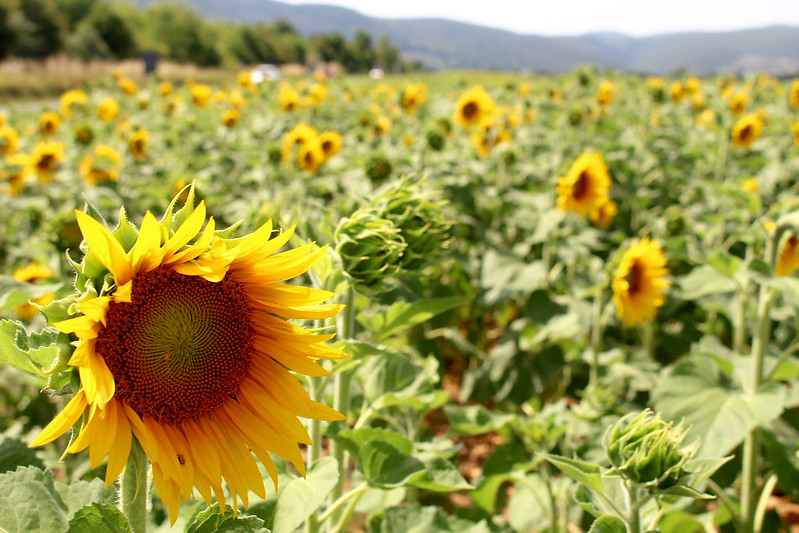
Top: The towers of San Gimignano as seen from Certaldo; bottom: sunflowers somewhere off the side of the road… they’re everywhere.
Serving as the heart of the Etruscan civilization before the Romans rolled in, Tuscany is home to ancient ruins and a rustic character very unique to that area. As with all regions of the country, here there is a local Tuscan dialect, but it is also the birthplace of the standard Italian language, based on the language of the 14th-Century Florentine elite class (which I learned was an exceedingly complicated affair), and home to that quaint little historical period that you might have heard of called the Renaissance. In places like Firenze (Florence), Europe began to emerge from the Dark Ages and the Black Plague of the 1300s, thanks to the brilliance and creativity of people like Leonardo da Vinci, Michaelangelo, Dante Alighieri, and Galileo who made life-changing innovations in science, technology, architecture, literature, and art. From the handful of articles that I read, it sounds like Renaissance Florence was a progressive mecca to which artists, philosophers, and other great thinkers of the time flocked to share ideas. The Renaissance then spread north from the Italian Peninsula to mainland Europe, ushering in the modern era. #thanksitaly
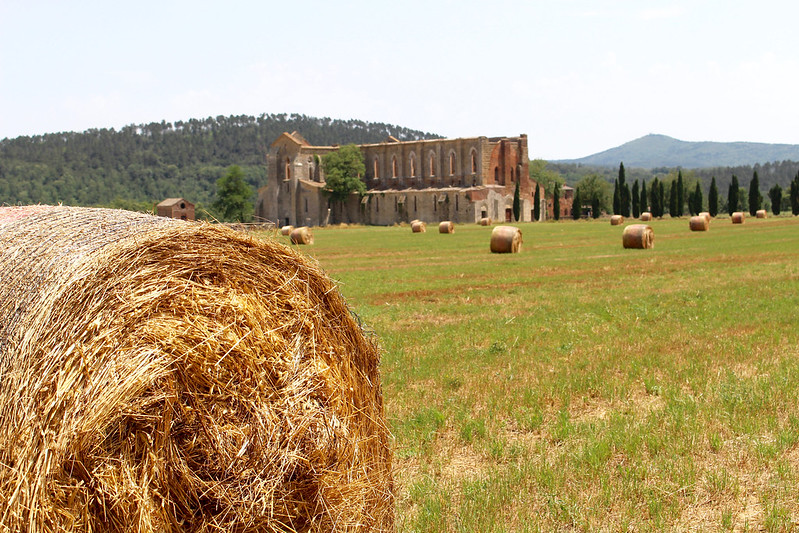
Top: View from Montepulciano; middle: medieval buildings in San Gimignano; bottom: ruins of the Abbazia di San Galgano near Siena.
Tuscany feels like a world tucked away in medieval times. It is nestled between the more industrial north of Italy and the regions to the south that tend to be more chaotic and economically disadvantaged. This north-central area of the “The Boot” is gifted with a magnificent bounty of local and natural resources that are the envy of the world. These include grapes, olives, grains, honey, legumes, truffles, and livestock, which are responsible for delicacies like Chianti wine, olive oil, pecorino cheese, and cinghiale (pronounced ‘cheeng-gee-AH-leh’, aka wild boar) salami. These are world-renowned products forged with painstaking care and tradition, and yet they retain a touch of coarseness that is characteristic of rustic Tuscany. One thing that is not particularly a highlight, for me anyway, is the bread. They make bread in Tuscany without salt, which is predictably rather flat in flavor. My Italian professor said that this allows the flavors of whatever you’re serving it with to shine, be it olive oil, tomatoes, garlic, or what have you. Tuscany is home to great examples of Italy’s cucina povera, peasant cuisine. Their pastas are typically made without egg, only flour and water. One of my favorite Tuscan pasta shapes is called pici (pronounced like ‘peachy’), which are thick hand-rolled noodles often served cacio e pepe style, with truffles, garlic sauce (all’aglione), or meat ragù. Another favorite dish is pappardelle al cinghiale (wild boar sauce served over wide pasta ribbons). This one is life-altering if you’re lucky to have it somewhere special. I almost want to keep it a secret out of greed and jealousy, but I feel like it’s my responsibility to share this pasta joy with the world as a public service announcement– if you’re in Siena, you MUST visit Trattoria La Torre.
My very favorite place in Tuscany, and that was a hard decision to make, is Siena. Exploring this medieval city feels like being transported into the past. The historic center takes you back to a time when Florence and Siena were bitter rival kingdoms, and glorious Gothic structures were built during periods of prosperity. The narrow alleyways meander past ancient stone buildings, splendid churches and monuments, and secret nooks and crannies in a maze that encircles the breathtaking Piazza del Campo; a few minutes away, the massive Duomo cathedral dominates Siena’s skyline, towering above terra-cotta rooftops. One of the best-known things about Siena is its famed horse race, called Il Palio. Different neighborhoods (called contrade) in Siena each have a horse represented in the race and the horses race around the Piazza del Campo; this much I knew about. What I learned on my trip last summer was that this is not exactly a fair or innocent horse race. The keeper of the villa where we stayed explained that this is a vicious, cutthroat race in which stakeholders from the various neighborhoods jockey to triumph over their rivals– by whatever means necessary, whether they be ethical or, mehhhh… not so much. I’m talking about tactics like paying a rider to take down the enemy contrada‘s horse, or bribing a rider to ride badly. The Senese people take this all very seriously; winning the Palio is a grand honor and not something to be taken lightly. I’ve never experienced watching the Palio in person, but it’s one of those bucket list items.

Top: Piazza del Campo in Siena; middle: roof view of the Duomo of Siena; bottom, clockwise from top-left: Zoom lens view of San Gimignano, medieval piazza in San Gimignano, building on the Ponte Vecchio in Florence, lavender patch on the way to the Abbazia di San Galgano, Duomo of Florence, tower and cupola of the Duomo of Siena, vineyards in Sinalunga.
One of my favorite experiences from my visits to Tuscany was taking a cooking class years ago in the hilltop town of Certaldo, a village that winds its way up to an old walled city on top. My then-boyfriend-now-husband and I took a class at Cucina Giuseppina. The beautiful teaching kitchen was located overlooking the edge of the hillside and the beautiful Tuscan fields below. We made multiple courses and sipped wine and nibbled on food for the better part of an afternoon, and I never wanted to leave. I think that this experience was integral to building my interest in studying food on such an intimate level, and it unquestionably helped me fall in love with Tuscany. I learned probably for the first time how amazing simple, natural ingredients are, and how they can be transformed with the magic of a little heat and olive oil. I also used the largest knife I’d ever seen in my entire life to chop garlic– the blade was literally, actually the size of a machete. (And you better believe I brought one home in my suitcase!) One of my favorite things about meeting people in Italy is that they are very quick to treat you like family. In Giuseppina’s kitchen, it felt so cozy and comfortable and friendly like we had known her and her son for years. I’ve taken countless cooking classes in my life– none holds a candle to this one.
Since I can’t be there now, memories and photos have to suffice, and one of my favorite things to do is recreate the best dishes that I ate there. A couple of years ago, a friend there made us an apple cake, otherwise known as torta di mele, which is apparently a very traditional Tuscan dish. They actually eat it more for breakfast than dessert, but of course you can eat it whenever your Italian sweet tooth strikes! When I was trying to figure out what to make to represent Tuscany in my Italian blog series, apple cake was a no-brainer. Ideally, you want your cake to be moist and dense on the bottom, with the apples practically melting into it on top. I found a promising recipe in Francine Segan’s Dolci: Italy’s Sweets, which looked so luscious that it was actually featured on the book cover.
What makes this cake specifically Tuscan? I’m not totally sure, but you see this style of apple cake baked in homes as well as bakeries, and if there’s something they adhere to traditionally in Italy, it’s food. I realized that there’s no butter (or liquid fat of any kind, for that matter) in the cake batter, and I wonder if that is a result of cooking when butter was a scarce commodity in ancient times? Across recipes that I looked at, the characteristics that Tuscan cakes seemed to have in common are no stand mixers, apples piled on top, and golden, glossy tops. Some recipes had butter or oil, and others didn’t. My most important requirement was that it had to be something my imaginary Italian grandmother (if only!) could have made without any fancy equipment or ingredients. The beauty of Italian desserts is their simplicity– like savory Italian cuisine, they elevate simple, natural ingredients through simple methods.
I chose to go with the Segan recipe because it was mesmerizing on the cover of the book, and I had high hopes, but… it was rather disastrous. This cake is not that recipe, but I just really need to vent, because this was quite a recipe experimenting ride. I will save you the agonizing details, but suffice it to say that I made SIX different versions of this cake after the first one completely overflowed its pan. I tweaked the quantities and ingredients, tried different pans, performed sacred religious cake rituals, and absolutely nothing would yield a cake that both looked like the photo and was edible. The cake was either dry, burnt, raw in the middle, or just anemic-looking; most went right in the trash. I even tried two other similar recipes, but they just didn’t excite me.
At this point, after about two dozen apples and a lot of Italian “00” flour wasted, I wanted to cry and break things. But GUYS. Then something happened… I took a break for a year (yes, these apple shenanigans started last Fall), and then I tried again on the magical internets to find a recipe. I came across a torta di mele by one Lynne Rossetto Kasper in a book called The Italian Country Table. It seemed to have the right elements, although it included a meringue topping, which was not part of my vision. I simply omitted it and scattered apple slices on top instead. What I liked about this recipe, which I hadn’t seen in any other recipe, was that it had a thin bottom crust. I hypothesized that this would help the cake bake more evenly– although I guess I didn’t really have any scientific reason to think that. Lucky for me, this is just what happened. The entire cake from edge to center was beautifully baked, slightly custardy, and perfectly sweet-tart due to the Granny Smith chunks that I tossed in. And this crust mixture is made from the same mixture as the cake batter, so you’re still only making one thing. The cake is apple-y, moist, not too sweet, with burnished edges– in other words, just what I was hoping for. P.S. It was even tastier on the second day!
Finally, after all the trials and tribulations, I had a lovely Torta di Mele that’s terrific for Fall, whether or not you’re trying to channel Tuscany. I think it would be great with a crème anglaise sauce to pour over it… though Italians would probably not do so!
This is the 6th installment of my series on Italian regional desserts. Start here for an intro to Italian regional cuisine, my experiences traveling in Italy, and information about Italian pantry items for baking. Next is a region that I hope to get MUCH better acquainted with in the future: Emilia-Romagna.
Torta di Mele (Tuscan Apple Cake)
Adapted from The Italian Country Table by Lynne Rossetto Kasper
Yields 1 9″ round cake
Both tart and sweet apples work here. I used Granny Smiths because I prefer tart, crisp apples in general, but I imagine that McIntosh or other sweeter varieties would be great as well.
For the cake:
- 2 cups (240g) + 3 tablespoons unbleached all-purpose flour, divided
- 1½ cups (300g) sugar
- ⅛ teaspoon kosher salt
- 1½ sticks (6 ounces) cold unsalted butter, cut into small pieces
- ¾ cup (180mL) milk
- 2 large eggs, at room temperature, lightly beaten
- Grated zest of 1 large lemon
- 1 teaspoon pure vanilla extract
- 1 tablespoon baking powder
- 5 small apples (about 1⅛ pounds), peeled and cored, 2 cut into small dice & 3 cut into thin slices
Preheat an oven to 375°F and position a rack in the center. Grease the bottom and sides of a 9″ springform pan, and line the bottom with parchment paper. Grease the parchment and flour the bottom and sides of the pan.
In a large mixing bowl, toss together the 2 cups (240g) flour, the sugar, and the salt, then add the butter chunks and rub them into the dry ingredients with your fingers until the mixture is evenly crumbly.
Transfer 1 cup of the crumbs (about 180g) to the prepared springform pan and press them lightly and evenly across the bottom and about ½” up the sides all the way around. The crust should be about ⅛” thick. Set aside.
Make a well in the remaining crumb mixture. Pour in the milk, eggs, lemon zest, vanilla, the remaining 3 tablespoons flour, and the baking powder. Carefully whisk the wet ingredients together until mostly smooth without incorporating crumbs, then switch to a wooden spoon and stir in the crumbs. The batter should be well-blended except for a few lumps. (Break up any large pockets of flour.) Fold in the diced apples.
Scrape the batter into the pan and lay the apple slices across the top in a pretty pattern (or the arrangement of your choice) covering most of the surface. (I left some uncovered batter around the edges and here and there, because the original recipe says that the meringue, which I omitted, should not completely cover the cake because it affects baking.)
Bake the cake for 60-70 minutes, or until the top is a deep golden brown and a toothpick inserted into the center comes out clean. If the cake is browning too quickly, loosely cover it with a piece of foil.
Set the cake pan over a wire cooling rack and let it cool for about 30 minutes. My cake stuck to the sides, so I ran a sharp knife between the cake and the pan sides. Unclasp the springform pan and slip off the ring; let the cake cool completely before trying to move it further.
Store the torta di mele in a cake carrier or tightly wrapped in plastic for 2 days, or up to a week in the refrigerator. The cake can be rewarmed in the microwave or oven.

Bottom: Façade of the Duomo cathedral in Siena.
© Dafna Adler & Stellina Sweets, 2017.
SaveSave







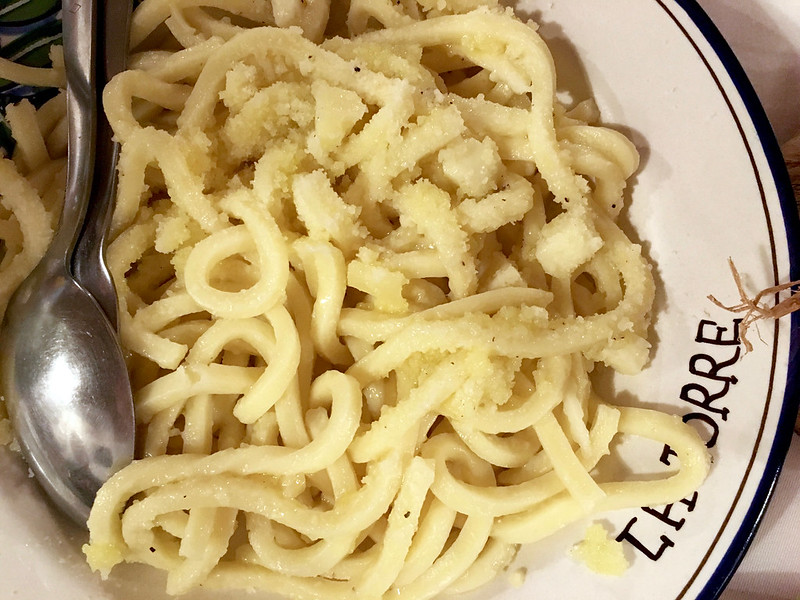

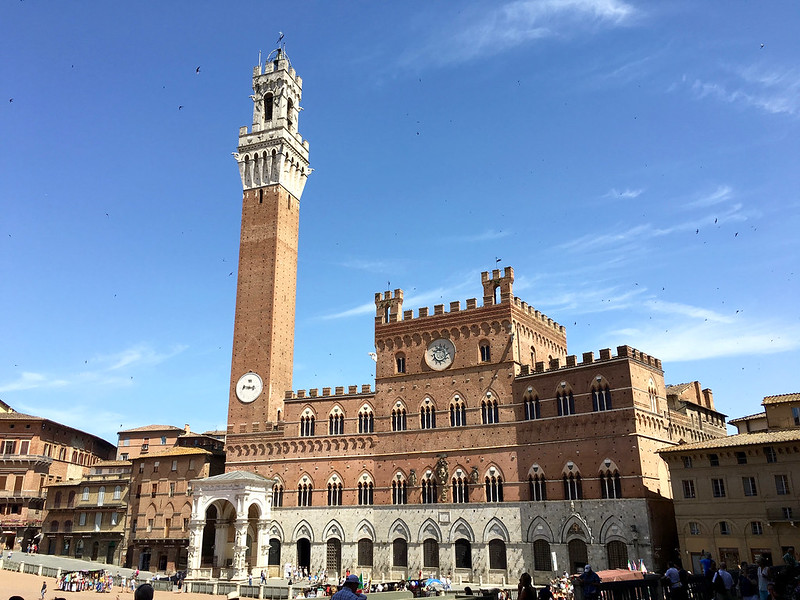
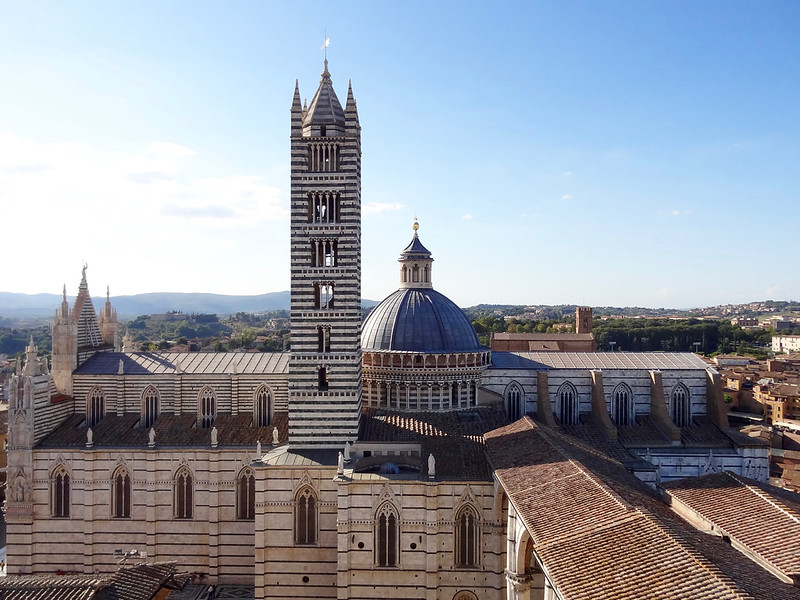
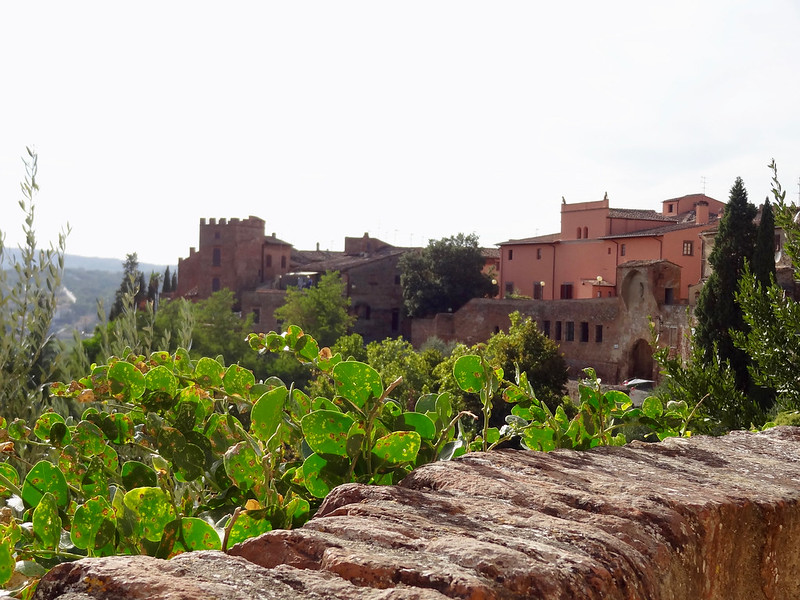
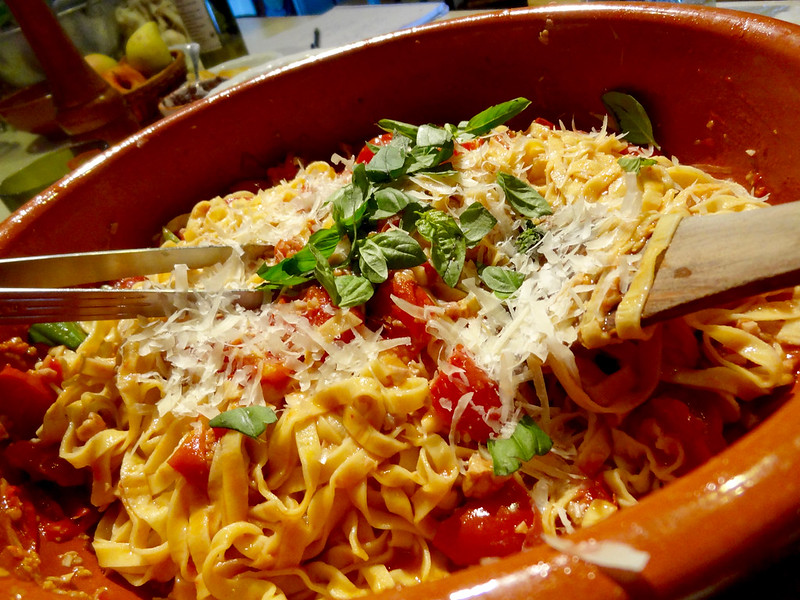


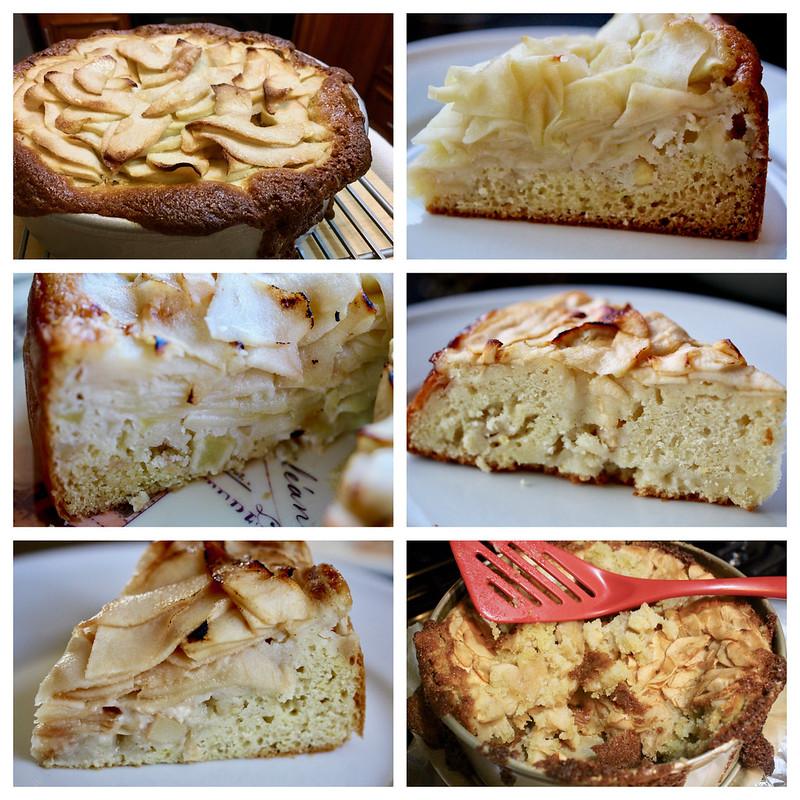
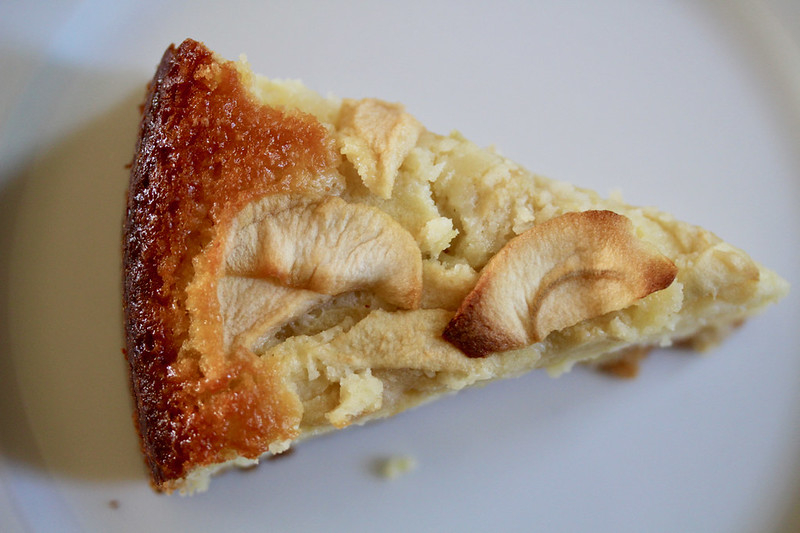
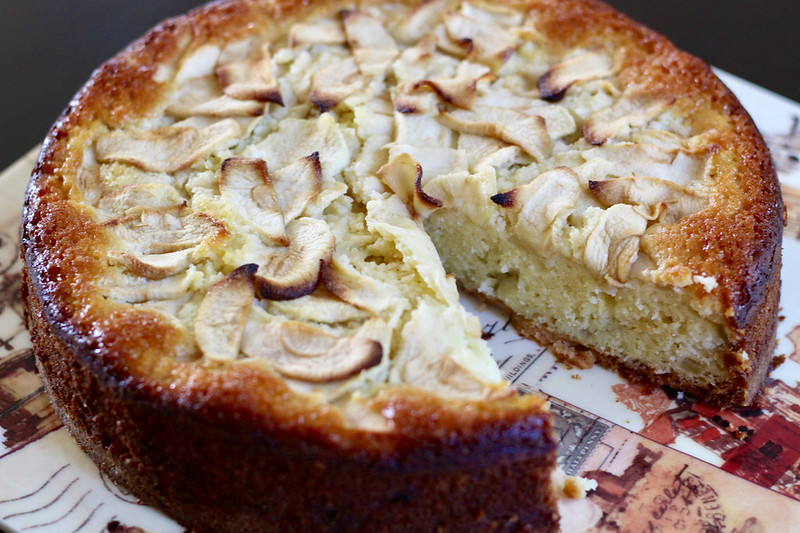

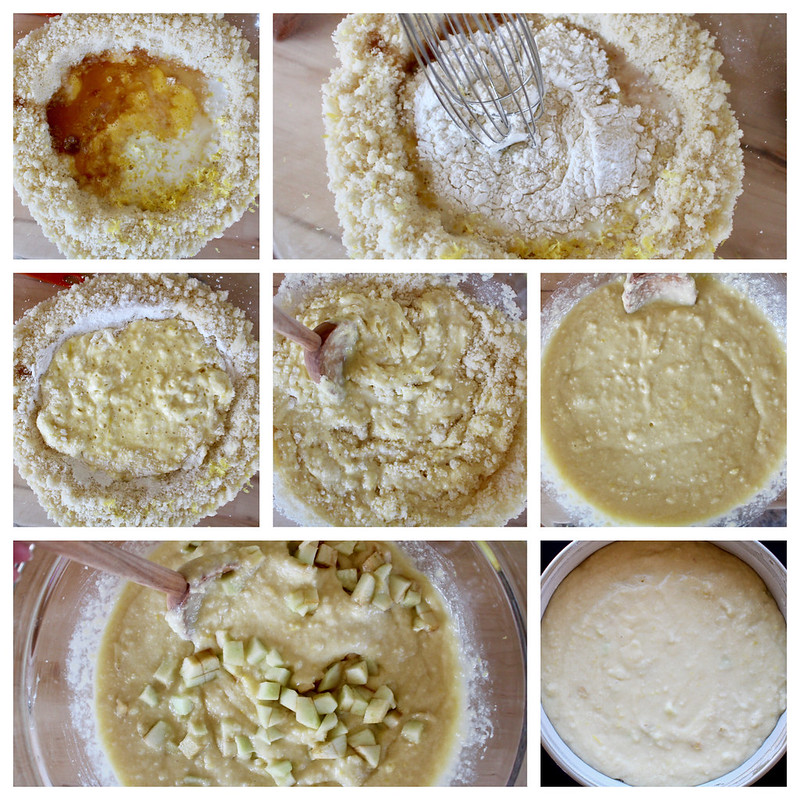


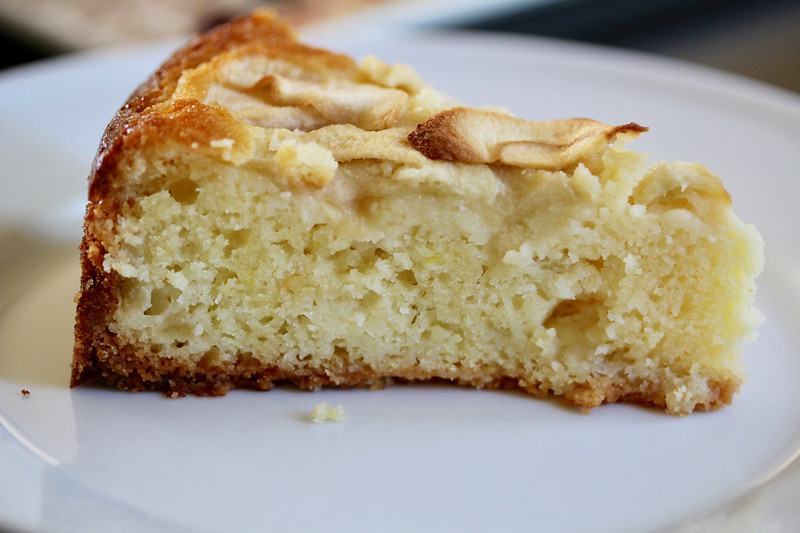













2 Responses